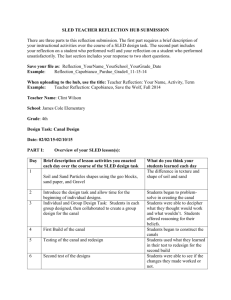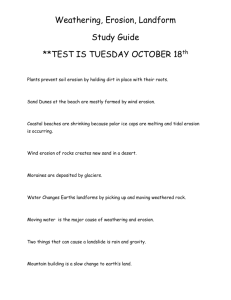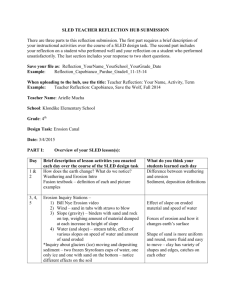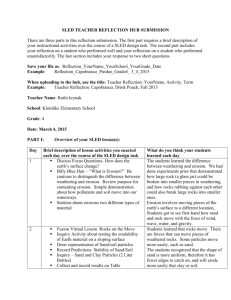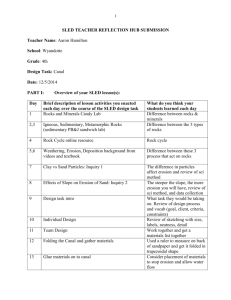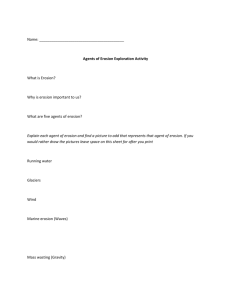erosion design
advertisement
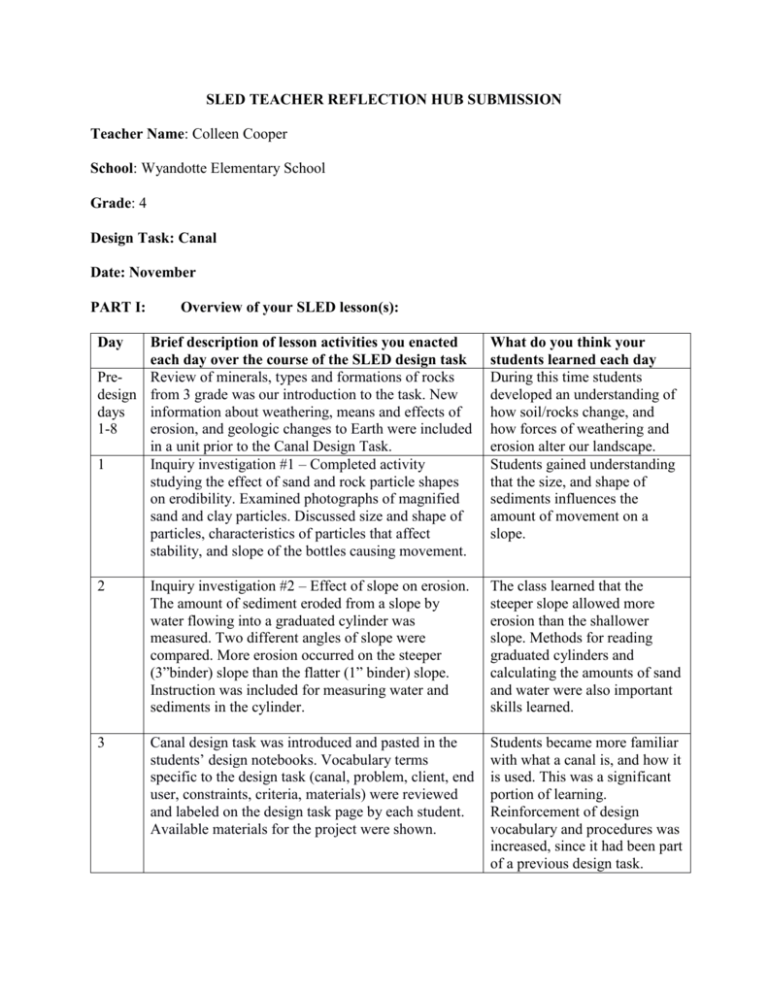
SLED TEACHER REFLECTION HUB SUBMISSION Teacher Name: Colleen Cooper School: Wyandotte Elementary School Grade: 4 Design Task: Canal Date: November PART I: Overview of your SLED lesson(s): Day Brief description of lesson activities you enacted each day over the course of the SLED design task PreReview of minerals, types and formations of rocks design from 3 grade was our introduction to the task. New days information about weathering, means and effects of 1-8 erosion, and geologic changes to Earth were included in a unit prior to the Canal Design Task. 1 Inquiry investigation #1 – Completed activity studying the effect of sand and rock particle shapes on erodibility. Examined photographs of magnified sand and clay particles. Discussed size and shape of particles, characteristics of particles that affect stability, and slope of the bottles causing movement. What do you think your students learned each day During this time students developed an understanding of how soil/rocks change, and how forces of weathering and erosion alter our landscape. Students gained understanding that the size, and shape of sediments influences the amount of movement on a slope. 2 Inquiry investigation #2 – Effect of slope on erosion. The amount of sediment eroded from a slope by water flowing into a graduated cylinder was measured. Two different angles of slope were compared. More erosion occurred on the steeper (3”binder) slope than the flatter (1” binder) slope. Instruction was included for measuring water and sediments in the cylinder. The class learned that the steeper slope allowed more erosion than the shallower slope. Methods for reading graduated cylinders and calculating the amounts of sand and water were also important skills learned. 3 Canal design task was introduced and pasted in the students’ design notebooks. Vocabulary terms specific to the design task (canal, problem, client, end user, constraints, criteria, materials) were reviewed and labeled on the design task page by each student. Available materials for the project were shown. Students became more familiar with what a canal is, and how it is used. This was a significant portion of learning. Reinforcement of design vocabulary and procedures was increased, since it had been part of a previous design task. 2 4 Instruction was included in how to draw the canal shapes from a top (bird’s eye) view and side view. Materials were shown and students examined/handled the materials. We reviewed the basic requirements for drawing size, neatness, labels, list of materials. Time was given for drawing individual designs in notebooks. Teacher approval for individual design sketches was given. Team members (3 students/team) collaborated to explain their individuals design ideas. Discussion of possible team designs followed, and decisions made for final team design. Individual team members sketched the canal design in notebooks with labels, and materials list. Teacher approval was given for each design. Methods for drawing varied viewpoints were review, but not mastered. Students gained understanding of ways to sketch materials (cloth, screen, craft sticks), and neatly list materials. 6 Instruction on how to measure and draw lines of 4 in, .5 inches on the sandpaper for the canals was included in math that day. Teams gathered materials and built team canal designs. 7 Erosion prevention designs were tested. Water and sand were collected in a graduated cylinder. Total run-off from each design was recorded on data sheets in design notebooks. Data collection sheets were glued in notebooks. For each design, students measured the total run-off, and calculated the total amount of sand, and water for each design. These measurements were made in mm, rather than mL, due to the lack of measurement markings in the 1 – 10 mL portion of the graduated cylinders. Each team presented designs of canals, and aspects of it that the group thought would reduce erosion. Measuring and line drawing were improved. Cooperation, teamwork, and problem-solving were increased. Skills for observing increased. 5 8 9 Post-test on erosion canal was given. Students independently completed Wrap-up Activity answers in their notebooks to evaluate their design. Redesign of the canal was completed individually. Students learned more skills for explaining their ideas and collaborating to reach common design ideas. Clear illustration and labeling of sketches was improved. Measuring and recording data accurately on charts was reinforced through practice. Students used of math operations to calculate amounts of sand and water in a real world situation. Evaluation methods of the effectiveness of erosion prevention were practiced. Students learned more about evaluation of effectiveness of erosion prevention. Please answer the questions below: 1. What worked well? Students gained a stronger understanding of how canals are constructed and the need to reduce the amount erosion in canals. Building the model increased student concepts of how the slope of the banks influences the amount of sediment eroded. Visualization of the end result of running water was challenging. After completing inquiry activity #2, students predicted the outcome of flowing water more 3 accurately. That inquiry was cited much more often by students than the first inquiry concerning sediment particle shape. Gaining familiarity with novel construction materials was a result of this task. Fiberglass screen, cheesecloth, and pipe cleaners were considered uncommon by most students, so they expanded knowledge of possible building materials. Accurate measurement to draw fold lines on the sand paper was a valuable lesson. Most students had had little prior experience with drawing carefully measured lines and folding paper. During construction, several teams discovered that the glue was not very effective in holding the screen or cheesecloth. They adapted quite quickly to the situation by selecting masking tape or duct tape to construct their prototype. The design process was challenging, yet helped the group members express ideas about how to best meet the canal design task. Students needed to listen, consider alternatives, and reach a consensus on designing a plan. Final construction required more collaboration and sharing of the work. Those were very beneficial activities for the students. 2. What are two ways you can improve your efforts toward integrating design? After the prototype testing and presentation to the class, students reflected on how their designs worked. Many had opportunities to redesign the canal while incorporating what they had learned from the prototype performance. Allowing time for research about erosion prevention at this point may add to the accuracy of their concepts. I could improve students’ learning by including a written reflection about the redesigned canal. If students wrote reasons for the changes in the design, and how the alterations would improve the anti-erosion aspects of the canal could allow greater insight into the students’ mastery of the science and engineering concepts. I was not anticipating the level of difficulty students encountered with measuring and marking the fold lines. In the future, I would add two or three extra sessions of measuring and folding prior to the actual construction of the canal. This would supplement mathematics instruction, and strengthen important skills that are useful in many real world situations. 4 PART II: Reflection#1 on student performance: The top two images are the prototype and the team design sketch. The student illustrated her design concept clearly. The design is simple, using minimal materials for the canal. The notebook entry (below the photo) is the student reflection after testing the prototype. She indicates alterations that were made during construction. The explanation of how the design worked shows the student’s understanding that erosion was prevented by the layer of screen covering the sides and base of the canal. She knows that the screen sifts the sand to the base of the canal, thus preventing it from flowing out with the water. She also reflects that the quantity of sand was greater than her prediction. Her design, constructed prototype, and post-test reflection indicate her thoughtful consideration of the erosion problem throughout the activities from start to finish. 5 Reflection#2 on student performance: This student’s prototype actually performed better than the mastery student. The sketch was somewhat difficult to understand. The post-testing reflection written by this student indicates that the design worked, but no explanation was given for the functioning. There is no 6 reference to erosion, or the design elements that reduced the erosion. The student does not demonstrate an understanding of why the prototype worked. 7 PART II: Reflection #3 I have taught 4th graders about erosion and changes to Earth’s surface for many years. Students have had difficulty understanding the real effects of erosion, even when using videos, photographs and viewing erosion outdoors. Interest in preventing erosion has not been strong in 10 year olds. The real-life hands-on approach of this design task made erosion more easily understood. Students demonstrated active engagement in problem solving and far greater interest in reducing erosion. The design task situation seemed relevant to them, and increased their interest. Describe one thing in your practice you would improve upon next time you implement this engineering design task or another SLED design task. Several of my students created prototypes that used a structure that was dam-like in size and function. The next time I implement this design task, I will be more specific about the expectations of free-flowing water through the canal. The obstruction of the canal would undermine the functioning of the canal. I also will research ways to create layers of clay and sand on the banks of the canal prior to the construction of the erosion mitigation system. I believe that this would make the task more true to life. Students would have a more accurate simulation of the canal structure. I hope that would increase their understanding of erosion under the conditions of flowing water.

